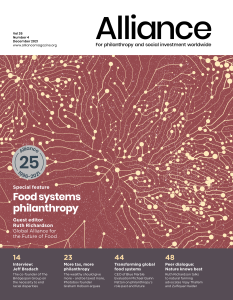Over the last half-century and more, global food systems have been dominated by the large-scale production of single crops produced for mass markets, culminating in the Green Revolution of the 1990s. While this transition from subsistence to industrialised agriculture has increased production, many of its effects have been detrimental and are becoming increasingly so.
This event explored some of the alternatives to the prevalent system and asked what it would take to produce a paradigm shift in which producers and distributors are treated fairly, the environment is not systematically degraded and all have access to healthy and nourishing food.
The event was moderated by Andrew Milner, associate editor of Alliance magazine, and the speakers were Ruth Richardson, executive director for the Global Alliance for the Future of Food; Iara Rolnik, programme director of Instituto Ibirapitanga and Zulfiquar Haider, head of programmes and strategy for the Azim Premji Foundation.
Mercer
 Amit Popat gave a brief introduction to Mercer, who sponsored the event. Mercer is ‘the largest investment consultant firm in the world’ and as part of their work advise on the endowment assets of around 350 foundations and non-profits. Popat listed four things that are on the minds of foundations when it comes to their investment portfolios, which Mercer advise on:
Amit Popat gave a brief introduction to Mercer, who sponsored the event. Mercer is ‘the largest investment consultant firm in the world’ and as part of their work advise on the endowment assets of around 350 foundations and non-profits. Popat listed four things that are on the minds of foundations when it comes to their investment portfolios, which Mercer advise on:
- How to manage portfolios in light of increasing inflation
- Where to allocate capital at the moment as equity prices are high
- Allocating to private markets
- How to integrate sustainability into their portfolios, with agriculture being responsible for ‘20% of contribution to carbon globally.’
Audience poll
The audience poll question was: between 2014 and 2019 did the number of undernourished people in the world fall, rise, or stay the same?
- 65% voted rose
- 34% voted fell
In fact, it did rise by some ’60 million people over that period to 690 million undernourished people in the world in 2019, even though primary crop production during that period was rising.’
Ruth Richardson
 Richardson began by introducing her organization the Global Alliance for the Future of Food, which is a ‘strategic alliance of philanthropic foundations with a mission to leverage our resources and our networks to shift food and agriculture systems towards greater sustainability, security and equity.’
Richardson began by introducing her organization the Global Alliance for the Future of Food, which is a ‘strategic alliance of philanthropic foundations with a mission to leverage our resources and our networks to shift food and agriculture systems towards greater sustainability, security and equity.’
The Global Alliance focuses on innovating and creating a new approach to funder collaboration on a global scale, and is currently made up of 31 foundations with commitments to food systems change, touching on topics including climate change, biodiversity, farmer empowerment and women’s rights.
Profound changes in the way food is grown, processed, distributed, consumed and wasted over the last decades have ‘led to a food system…that is ultimately not fit for purpose.’ Industrial food systems are ‘too dependent on fossil fuels’ and erode ‘human health, social cohesions, rural livelihoods and important social and cultural and spiritual traditions.’ They undermine the vital contributions of ‘farming, fishing and forest communities’ and promote an economic system that results in liabilities due to ‘hidden costs, global trade vulnerabilities, declining rural economies and increased inequality.’ Women, vulnerable populations, small farmers and marginalized communities carry an uneven burden of the all the negative impacts caused by the current industrial system.
In Brazil, the food question is becoming a significant part of public debate.
Richardson spoke about the Global Alliance’s seven shared principles to define the future of food and be used as a diagnostic tool. These principles are around renewability, resilience, equity, diversity, health, inclusion and interconnectedness.
Food systems are at the centre of many of the issues we face today including ‘climate change, global health pandemics, demographic shifts, local unrest and economic vulnerabilities.’ They are often the source of the problems, but also the ‘pathway to brilliant solutions.’
Richardson stated three things that philanthropy can do to aid food systems transformation:
- Philanthropy can help forge new insights. Global Alliance’s new compendium called ‘the politics of knowledge’ helps to understand the evidence for ‘agro-ecology, regenerative approaches and indigenous food waste’ to help further collective knowledge. Philanthropy can ‘reassert research as a public good, to use our platform as a means to amplify and validate diverse knowledge.’
- Mobilize evidence in a way that ‘shifts the needle of public concern to political action’ by facilitating ‘authentic, meaningful and actionable’ dialogue.
- Incite action in a number of powerful ways by ‘aligning their financial flows’ with other public and private funders to amplify the potential of more sustainable systems of agriculture.
Richardson challenged the community to take up these principles and hold ourselves to account: ‘we are the change and change we must.’ She identified three calls to action:
- Promoting integrated participatory rights-based governance.
- Reasserting public research for the public good.
- Mainstream the true cost of food systems by identifying the positive and negative externalities, and supporting the positive.
Iara Rolnik
 Instituto Ibirapitanga is a young Brazilian family foundation that operates two programmes on racial equity and food systems. Rolnik discussed how racial equity is a ‘key intersection in the debate around food, and talking about food in Brazil means addressing structural inequalities and contradictions.’
Instituto Ibirapitanga is a young Brazilian family foundation that operates two programmes on racial equity and food systems. Rolnik discussed how racial equity is a ‘key intersection in the debate around food, and talking about food in Brazil means addressing structural inequalities and contradictions.’
Brazil is the third-largest food producer in the world and the second-largest global exporter of food. However the country also has a large population living with hunger, and in 2020 there were ‘90 million people in Brazil living with hunger.’ Hunger and malnutrition in the population coexist with sharp increases in obesity and chronic disease, largely due to over-consumption of processed food.
Brazil is also known for its biodiversity, largely concentrated in the Amazon. Its large food exports rely on gains of ‘extensive and industrialized agriculture that’s responsible for enormous environmental damage.’
Brazil suffers from ‘immense inequalities marked by the persistence of racism, which has been deepened by the economic recession, the pandemic and the rise of political authoritarianism.’ Rolnik argues that these issues must be considered as factors in the systemic problems affecting the food system and that we need ‘more integration of the food systems and racial equity agendas.’
Brazil has the second-largest black population in the world, representing 56% of the country’s population. However racial inequalities in access to healthy food persist; ‘a recent national household budget survey shows that the growth in consumption of processed products is 10 times greater’ than the white population. We must be more open to the ‘plans and experiences of black people when it comes to building a fair, healthy and sustainable food system based on their history and knowledge.’
The fight against hunger could also be a fundamental aspect of the fight against racism, and factors including ‘city planning and design, housing, wages and education’ must be considered as they impact food insecurity.
‘We cannot transform food systems and then devise strategies for inclusion of these perspectives,’ Rolnik concluded. ‘This will either be part of the transformation or will not be transformative at all.’
Zulfiquar Haider
 Haider began by introducing the Azim Premji Foundation, an Indian foundation that focuses on making ‘a significant difference in the lives of the most vulnerable people’, looking at issues including homelessness, domestic violence, small and marginalized farmers, gender-based violence and access to legal aid. They also look at larger societal issues such as public education, sustainable agriculture, strengthening democracy and health issues. Azim Premji Foundation has its own university in the city of Bangalore and is looking at setting up three more around the country in the coming few years.
Haider began by introducing the Azim Premji Foundation, an Indian foundation that focuses on making ‘a significant difference in the lives of the most vulnerable people’, looking at issues including homelessness, domestic violence, small and marginalized farmers, gender-based violence and access to legal aid. They also look at larger societal issues such as public education, sustainable agriculture, strengthening democracy and health issues. Azim Premji Foundation has its own university in the city of Bangalore and is looking at setting up three more around the country in the coming few years.
Fifty-five per cent of India’s population are farmers, and 85 per cent of these farmers have small landholdings with precarious livelihoods. This is becoming increasingly the case due to the negative effects of ‘chemical-intensive farming, the impact of climate change and erratic rainfall,’ which has resulted in droughts in many areas of the country. Azim Premji foundation focuses on building resilience in the sector and the wellbeing of farmers, which includes building social safety nets for farmers and aiding collectivization to give the farmers more bargaining power.
They are also working to address issues of malnutrition and providing community health interventions, as health expenditure can often cause people to spiral into debt. They have a centre for climate change at their University which sponsors research and runs courses. Freshwater is a topic they will be focusing more on in the coming years, and ‘agroecological approaches offer us an important solution in that space,’ as the water requirements of irrigation can be curtailed.
Haider then spoke about the Andhra Pradesh community-managed natural farming programme, which involved governmental collaboration in the province of Andhra Pradesh. Azim Premji foundation worked with the local governmental, civil society organizations and the community to come up with ‘a package of practices breaking down agroecological practices into a set of principles and activities.’
We cannot transform food systems and then devise strategies for inclusion of these perspectives. This will either be part of the transformation or will not be transformative at all.
They recognized the ‘implicit knowledge that farmers carry based on their experience, and had them taking this methodology to other farmers.’ Now, close to half a million people have moved into practising agroecological farming and there is ‘significant resilience across the farmers in Andhra Pradesh.’ Despite heavy rainfall, farmers practising natural farming suffered less crop damage compared to chemical-intensive farming.
Productivity figures suggest that productivity has been either constant, increased in many crops, and in some crops has dipped for the first year or two and then restabilized. The fact that the movement is growing and expanding are ‘very strong indicators that something phenomenal is happening in the state of Andhra Pradesh.’ There are currently ongoing evaluations of the programme taking place, with results likely to come in 6 months time.
Haider spoke briefly about the challenges of running the programme, which included navigating a change in local government and pushback from the chemical fertilizer and pesticide industry. However, the state government continues to support it and there is commitment from the national government to launch more programmes such as these across the country. Overall, the farmers’ response to the programme has been very positive. In areas where indigenous communities live, fewer chemicals were used so the transition was faster and easier, and poorer farmers found natural farming very attractive as it enabled them to avoid the additional upfront costs of chemical products. However, the uptake has been slower in monocrop areas, as multi-cropping systems is an important element of natural farming.
Audience poll
The question was: how much of the world’s water does agricultural irrigation use? The correct answer was 70 per cent, which was answered by almost half of the attendees.
Panel Q&A
The first question was from Michael M for Haider, asking how philanthropy supports civil society organizations in Andhra Pradesh. Haider responded that they are working with around 15 civil society organization partners within the Andhra Pradesh province on agroecological farming.
 The next question came from Emily Johnson of the Good Food Institute, who asked: how do the panel see the role of consumer choice in changing food systems? How can philanthropists consider this when making decisions about how to have the most impact on their giving?
The next question came from Emily Johnson of the Good Food Institute, who asked: how do the panel see the role of consumer choice in changing food systems? How can philanthropists consider this when making decisions about how to have the most impact on their giving?
‘It’s really critical to look at the entire value chain,’ Richardson responded and discussed the tools that enable us to do that. TEEBAgriFood, which she works with, is one of the most ‘holistic, comprehensive true-cost accounting frameworks that we developed in partnership with the European Commission and UN Environment Programme.’ She thinks of it as a ‘giant excel spreadsheet,’ where you can see the entire food value chain with all of its impacts, which becomes ‘a framework for us to see and understand systems.’ The consumption piece is critical and Richardson agrees that we need to look at consumer choice, however, we must also be aware that ‘a lot of people don’t have choice.’
The global debate has been very polarised.
Rolnik agreed that this was a problem, and spoke about how her foundation is supporting initiatives for better regulation and labelling of food products to help people make healthy food choices. She also mentioned public policy initiatives in Brazil such as the national guidelines for food and how they are encouraging people to minimise consumption of ultra-processed food.
Haider jumped in with the Indian perspective, saying ‘we still don’t have enough supply chains for differentiated food.’ Organic produce tends to be niche and expensive, however, farmers know the value of it and if they are able to, will set aside some land to grow organic food for their own consumption.
The next question came from Charlotte Fletcher, who asked: how does philanthropy envision working with civil society to ensure a just livestock transition that helps meet SDGs while protecting smallholders, indigenous peoples and frontline communities? What gaps in thinking and theories of change do you currently see?
‘The global debate has been very polarised, which is not helpful,’ said Richardson, adding that getting rid of all livestock and going meat-free isn’t a helpful position to take and that the debate must be opened up. She referred to the Global Alliance’s principles and how they can be applied to livestock, to think about climatic and community resilience, the diversity of protein intake, and issues of equity. The principles are a starting point to ‘have a more constructive conversation about…one of the most contentious debates on the planet right now.’
Wrap up
Each of the panellists gave a quick summary of their key takeaways from the discussion. Haider went first, stating that he’s happy to see a wider global consensus that ‘we need to take these issues seriously and collectively, not only food systems and its consequences for people, but also addressing the climate change challenges associated with it.’ He wants to see more academic research and knowledge production addressing it, and more focus on agroecological farming over chemical-intensive farming.
Rolnik agreed and talked about how it’s a big opportunity for ‘systemic thinking about food.’ Food systems are a global issue and must be faced collectively. In Brazil, the food question is becoming a significant part of public debate, which is a great opportunity for change.
Richardson encouraged philanthropy to ‘think about how interconnected these issues are,’ in relation to the topics brought up during the event: racial equity, climate change, farmer empowerment and freshwater use. If philanthropy can ‘find ways to support those interconnections, they will find amazing benefits in terms of the positive impacts.’
Watch a playback of the event:
Annmarie McQueen is the Marketing, Advertising, and Events Manager at Alliance.
This event wraps up Alliance’s 2021 event programme. We’ll be releasing more information about our 2022 events in January. To stay up to date, make sure you’re signed up for our newsletter.
To ensure that you’ll always be able to attend Alliance events free of charge, subscribe now with a 20 per cent discount using the code DECEMBER20.



Comments (0)